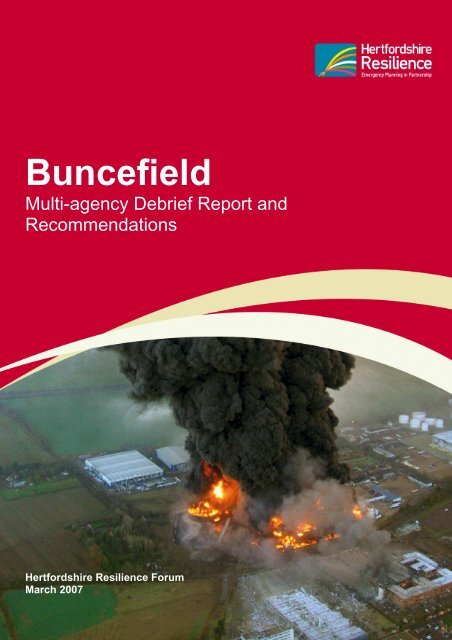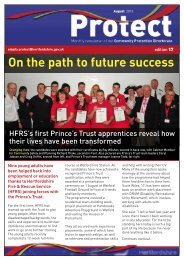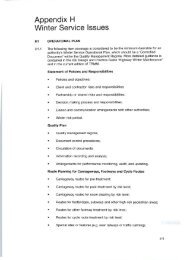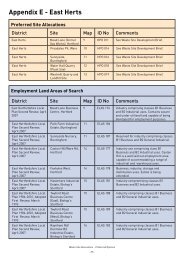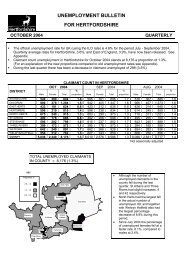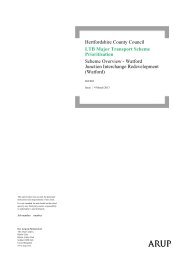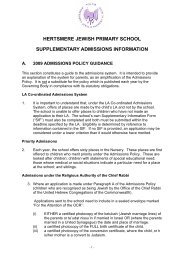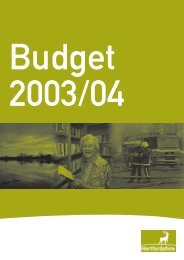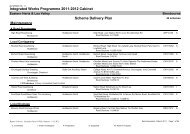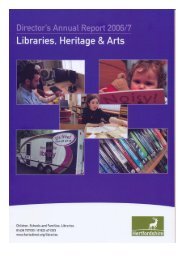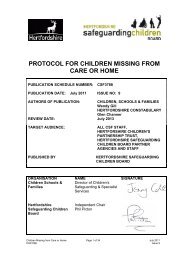Buncefield: Multi-agency Debrief Report and Recommendations
Buncefield: Multi-agency Debrief Report and Recommendations
Buncefield: Multi-agency Debrief Report and Recommendations
Create successful ePaper yourself
Turn your PDF publications into a flip-book with our unique Google optimized e-Paper software.
<strong>Buncefield</strong><strong>Multi</strong>-<strong>agency</strong> <strong>Debrief</strong> <strong>Report</strong> <strong>and</strong><strong>Recommendations</strong>Hertfordshire Resilience ForumMarch 2007
FOREWORDThe <strong>Buncefield</strong> oil storage depot explosion <strong>and</strong> subsequent fire presented a large number ofchallenges for Hertfordshire’s emergency responders not least of which were the magnitude<strong>and</strong> prolonged nature of the response. We are rightly proud of the multi-<strong>agency</strong> response tothis emergency, which has received considerable praise.The incident has also demonstrated the benefits of a strong Local Resilience Forum (LRF)where senior officers from across those organisations meet regularly within the LRF, underst<strong>and</strong><strong>and</strong> trust one another <strong>and</strong> whose member organisations have a history of planning, training <strong>and</strong>exercising together as well as learning from the response to previous major incidents.I’d like to take this opportunity to repeat my thanks to all those involved in the response: themany responding organisations which make up Hertfordshire Resilience (the county’s LRF), themany Fire <strong>and</strong> Rescue Services from across the UK who supported our own Fire <strong>and</strong> RescueService in the response <strong>and</strong> also our regional <strong>and</strong> national partners in both the public sector<strong>and</strong> industry.We were fortunate not to be dealing with any fatalities. Nevertheless, the impact of the incidenton the residents <strong>and</strong> businesses of Hemel Hempstead was significant <strong>and</strong> continues some 15months after the explosion.Since December 2005, we have undertaken a measured process, initially within organisations,<strong>and</strong> subsequently on a multi-<strong>agency</strong> basis to reflect on our response <strong>and</strong> draw out a number oflessons learnt. Many examples of good practice <strong>and</strong> professionalism have been identified.There are also some areas where, with the benefit of hindsight, we may have approachedthings a little differently or areas where further work is required to enhance responsecapabilities.Hertfordshire Resilience recognises the importance of sharing learning with the wideremergency planning community <strong>and</strong> we have produced this report, as part of a series ofinitiatives, to share our experiences <strong>and</strong> that learning. The LRF will be drawing up its ownaction plan to address the specific issues <strong>and</strong> work areas which we have identified for our ownResilience Forum. We hope others will find it useful in reviewing their own plans <strong>and</strong> localresilience arrangements.Although, we hope that there will not be another “<strong>Buncefield</strong>”, we believe that the lessonsidentified in our own response to that particular incident, could be applied to other majorincidents <strong>and</strong> emergencies <strong>and</strong> hope that if ever others are faced with an incident withconsequences similar to <strong>Buncefield</strong>, they will benefit from our experience <strong>and</strong> the learningcontained within this report.Caroline TapsterChair of Hertfordshire ResilienceMarch 2007<strong>Buncefield</strong>: <strong>Multi</strong>-<strong>agency</strong> <strong>Debrief</strong> <strong>Report</strong> <strong>and</strong> <strong>Recommendations</strong> Page 1 of 26
INTRODUCTIONThe recommendations contained within this report are the product of a series of debriefs. Eachorganisation within the Local Resilience Forum (LRF) conducted their own internal debriefs priorto taking part in the multi-<strong>agency</strong> debrief, which had the following objectives:1. To review the multi-<strong>agency</strong> response to the <strong>Buncefield</strong> Oil Storage Depot major incident<strong>and</strong> examine the effectiveness of that multi-<strong>agency</strong> response at a Strategic, Tactical <strong>and</strong>,where relevant, Operational level;2. To highlight areas of good practice;3. To identify areas <strong>and</strong> or issues where the multi-<strong>agency</strong> response went less well <strong>and</strong> couldbe improved upon;4. To make recommendations to enhance future multi-<strong>agency</strong> responses to major incidents;5. To share the learning from the multi-<strong>agency</strong> debrief with the emergency planningcommunity nationally.This report draws principally on the output from sessions facilitated by Professor JonathonCrego from the International Centre for the Study of Critical Decision Making, at which all of thekey agencies involved in the multi-<strong>agency</strong> response to the <strong>Buncefield</strong> incident, at either aStrategic of Tactical level were represented.Professor Crego’s event generated a wealth of very useful information, which was thenreviewed <strong>and</strong> analysed by representatives from the LRF to pull out the many significant issueswhich the debrief process had thrown up. Each of these issues, which are summarised below,is followed by a recommendation to address the issue concerned. The 42 issues have beencollated under the following sub-headings:• Preparation;• Incident response;• Issues at the Strategic Co-ordinating Group (SCG);• Wider issues;• Identified successes;• Recovery.The multi-<strong>agency</strong> response which was mobilised for the incident has received considerablepraise. Nevertheless, LRF agencies are committed to a process of continued improvement inorder to offer the highest possible level of response to those affected by a major emergency inHertfordshire. The debrief has highlighted a number of occasions where the response did notgo as well as one might have wished, however, these instances should not detract from themany examples of good practice <strong>and</strong> professionalism, for which the agencies <strong>and</strong> individualsinvolved in the response to the <strong>Buncefield</strong> incident have rightly been congratulated.<strong>Buncefield</strong>: <strong>Multi</strong>-<strong>agency</strong> <strong>Debrief</strong> <strong>Report</strong> <strong>and</strong> <strong>Recommendations</strong> Page 2 of 26
PREPARATION AND PLANNINGIssue 1Linkages between on <strong>and</strong> off-site COMAH plans to ensure a sharedunderst<strong>and</strong>ing of safety cases <strong>and</strong> the possible consequences of an off-siteincident.In the preparation of the <strong>Buncefield</strong> off-site plan(s), warning <strong>and</strong> informing arrangements werelimited to the Public Information Zone (PIZ) as defined by the Health <strong>and</strong> Safety Executive (HSE)which is itself informed by the site operators’ safety cases. In this instance, PIZ's for both theBritish Pipelines Agency (BPA) plan <strong>and</strong> the whole complex plan were 185 metres.Further consideration <strong>and</strong> guidance is required as to how operators’ safety cases <strong>and</strong>the HSE determine PIZ’s to inform the production <strong>and</strong> content of off-site plans.Issue 2Planning for a “worst case” scenario.The basis of the off-site planning arrangements was that of preparation for a single tank fire (the“worst case” scenario outlined in site operator safety cases) <strong>and</strong> this was used to shape anylikely off-site arrangements, which might need to be put in place. In hindsight the off-site planwould have been of more value during the incident had this “worst case” been stretched toinclude arrangements for a more catastrophic scenario, including one where the on-site controlmeasures/safety systems failed.To a certain extent, basing ones plans around a “worst case” worst case scenarios would runthe risk of generating more work <strong>and</strong> detailed contingency planning than might be judged areasonable or sensible use of resources (particularly since COMAH costs are met by the siteoperator). However, it is suggested that more challenges should be built into to LRF plans thanis the case at present. The use of “peer review”, undertaken on a formal basis, it is suggested,could provide that useful element of challenge which to date has not been part of multi-<strong>agency</strong>site specific plans.It is recommended that the LRF adopt a formal scheme of peer review <strong>and</strong> externalchallenge to ensure that plans extend further than a likely incident scenario <strong>and</strong> thatplanning assumptions should be rigorously challenged, including plans makingprovision for the catastrophic failure of on-site safety systems. It is suggested that thisapproach is employed for all site specific plans <strong>and</strong> not just for COMAH planning.Issue 3Proper engagement with all relevant local authorities in the development <strong>and</strong>implementation of off-site planning arrangements.In the specific instance of the <strong>Buncefield</strong> off-site plans, liaison with the local authorities wasalmost entirely centred on Dacorum Borough Council (DBC), despite the fact that the largesttank on the <strong>Buncefield</strong> complex (tank 12) was located within St. Albans City <strong>and</strong> District Council(SACDC). Whilst SACDC members were involved in the public consultation process, theinvolvement in the detailed planning arrangements was limited. This is partly explained by thelarge areas of open countryside <strong>and</strong> lack of any significant residential or commercialdevelopments within the PIZ. However; in hindsight it is felt that there could have been moreengagement with SACDC in the off-site planning process.Where PIZ’s cover more than one district/borough council area, both/all local authoritiesshould be fully involved in the preparation, development <strong>and</strong> exercising of off-site plans.<strong>Buncefield</strong>: <strong>Multi</strong>-<strong>agency</strong> <strong>Debrief</strong> <strong>Report</strong> <strong>and</strong> <strong>Recommendations</strong> Page 3 of 26
Issue 4Clearer routes into “health” advice to ensure that the appropriate elements of thehealth economy are properly engaged <strong>and</strong> consulted in the development of offsiteplans.In the preparation of off-site plans, the principal engagement with the health economy was viathe local Primary Care Trust (PCT) which at that time was in its infancy with public health a partof, yet separate from these arrangements. Consultation about the likely off-site scenarios waslimited <strong>and</strong> did not include any detailed consideration of public health messages, other than the“go in, stay in, tune in” guidance which could be considered as st<strong>and</strong>ard generic public advice.This was thought at the time to have been sufficient to meet the hazards which any likelyscenario might present, although no specific direct discussions had been held about thepossible toxicity of any likely smoke plumes or whether any particular sections of thesurrounding community might have been particularly at risk (i.e. children, asthmatics <strong>and</strong> theelderly). Had such work been undertaken, some of the tensions <strong>and</strong> concerns about the speedof health information being made available to the general public <strong>and</strong> incident responders maywell have been reduced.As part of the preparation <strong>and</strong> content of off-site plans, the local authority charged withthe production of the multi-<strong>agency</strong> off-site plan should consult with the PCT, HealthProtection Agency (HPA) <strong>and</strong> other relevant agencies to consider the development ofpre-prepared health guidance, based on the worst case scenario, linked to an agreedcommunications strategy which will also include advice/actions for the primary caresector.Issue 5Consideration for off-site sampling <strong>and</strong> monitoring arrangements as part of multi<strong>agency</strong>off-site emergency planning arrangements.Pre-incident multi-<strong>agency</strong> planning arrangements gave no specific consideration to sampling<strong>and</strong> monitoring arrangements in the event of an off-site incident being realised. During theactual incident the HPA <strong>and</strong> the Environment Agency established extensive public health <strong>and</strong>environmental monitoring arrangements using a number of diverse agencies, including thedeployment of London Fire Brigade <strong>and</strong> Ministry of Defence assets. It has been suggested thatthis is an area where additional planning <strong>and</strong> co-ordination, linked to the development of off-siteplans is required. In particular, there is a need to establish at a national level whichorganisation is responsible for commissioning <strong>and</strong> co-ordinating sampling to assist the work ofthe Health Advisory Team (HAT).Clarification be sought from central government as to who is responsible for the coordination<strong>and</strong> provision of sampling arrangements to ensure that the HAT has the bestpossible information upon which to base their advice to the SCG.<strong>Buncefield</strong>: <strong>Multi</strong>-<strong>agency</strong> <strong>Debrief</strong> <strong>Report</strong> <strong>and</strong> <strong>Recommendations</strong> Page 4 of 26
INCIDENT RESPONSEIssue 6Benefit of strong LRF/inter-<strong>agency</strong> relationships developed over a long period oftime.The multi-<strong>agency</strong> response to the <strong>Buncefield</strong> incident was characterised by a strong sense ofpartnership working, with Category One <strong>and</strong> Two responders within the LRF working veryclosely together in an open <strong>and</strong> constructive manner. This multi-<strong>agency</strong> “esprit de corp” wasjudged to have been the product of many years of inter-<strong>agency</strong> working, firstly under theumbrella of the Hertfordshire Emergency Services Major Incident Committee (HESMIC) whichhad been in existence some 25 years prior to any legislative requirement <strong>and</strong>, more recently, it’ssubsequent replacement by Hertfordshire Resilience; the name adopted by the county’s LRF.Operationally, there were very clear advantages in the fact that responders locally both at aStrategic <strong>and</strong> Tactical level knew one another, were clear about their own roles <strong>and</strong>responsibilities <strong>and</strong> worked closely to deliver agreed objectivesAll LRF's to review the relationships which exist across their constituent memberagencies to consider what, if any, practical actions could be taken to enhance thoserelationships to make them even more effective.Issue 7Prolonged duration of an incident can place considerable dem<strong>and</strong>s on resourcingof critical comm<strong>and</strong> <strong>and</strong> control structures. This is particularly important forsmaller agencies or those that do not traditionally have a 24-hour responseculture.In recent years, Hertfordshire’s experience of major incidents has been shaped by a series ofhigh profile train derailments, whilst each required a sizeable multi-<strong>agency</strong> response, they wereby the very nature relatively short-lived affairs, with many of the resources <strong>and</strong> personnel beingstood down after only a couple of days. The <strong>Buncefield</strong> incident was of an altogether differentmagnitude, not only in the amount of resources committed to the incident response. but also interms of its longevity. The prolonged nature of the incident <strong>and</strong> the requirement for staff to berelieved at regular intervals <strong>and</strong> given suitable periods of rest from what were on occasionssome very dem<strong>and</strong>ing environments, presented those agencies that would not normally operateon a 24-hour basis with particular challenges.Hertfordshire County Council offered to support DBC by representing them at the SCG <strong>and</strong> thisoffer was accepted. This then enabled DBC to concentrate their resources on managing thesituation locally with senior officers in the Authority able to focus on sustaining the localresponse without the additional dem<strong>and</strong>s of resourcing a multi-<strong>agency</strong> SCG. Nevertheless, it isimportant that all potential attendees are able to resource the SCG if requested <strong>and</strong> the possibleconsequences of this factored into organisational plans.All Category One responders to ensure that they have plans to cope with providing theright level of trained officer representation at meetings during prolonged incidents.All Category One responders need to be prepared to resource the SCG <strong>and</strong> to regularlyreview their representation.Issue 8Comm<strong>and</strong> <strong>and</strong> control rather than consensus.There were occasions when agencies more used to working in an environment characterised by<strong>Buncefield</strong>: <strong>Multi</strong>-<strong>agency</strong> <strong>Debrief</strong> <strong>Report</strong> <strong>and</strong> <strong>Recommendations</strong> Page 5 of 26
discussion, deliberation <strong>and</strong> working towards an approved consensus were expected to setaside that way of working, for one where “fast time” decision making <strong>and</strong> compliance was therequired group behaviour. This occasionally created tensions, particularly in respect of the timetaken to come back with information upon which important group decisions needed to be taken(i.e. advice about public health information or Personal Protection Equipment (PPE). Therewere other occasions where a “best guess” would have been preferable to no decision/noinformation at all, but a reluctance to take such a decision detracted from the efficiency of theresponse.In such circumstances, where a “best guess” is required, a range of options should bepresented with an assessment of the risks accompanying such options so that the SCG cantake suitably informed decisions, based on limited information.On this particular occasion, the delays did not have particularly serious consequences.However, it would not be difficult to conceive of other occasions or circumstances where suchdifferences could have created more significant difficulties <strong>and</strong> as such this is an issue meritingattention.All agencies must ensure that all their responding staff are trained to underst<strong>and</strong> the“comm<strong>and</strong> <strong>and</strong> control” protocols employed during the initial response to an incident. Itis essential that this is understood throughout each responding <strong>agency</strong>.Issue 9Consensus rather than comm<strong>and</strong> <strong>and</strong> control.Conversely, it was noted that a more reflective <strong>and</strong> consensus style of decision making leantitself to the management of the recovery phase of the incident, <strong>and</strong> this less prescriptiveapproach required those more used to working in a comm<strong>and</strong> <strong>and</strong> control environment tomodify their approach.Agencies who normally operate in a “comm<strong>and</strong> <strong>and</strong> control” culture must underst<strong>and</strong><strong>and</strong> be able to operate in the more consensual environment of the recovery stages of anincident.Issue 10Consistency of decision logging <strong>and</strong> communication of SCG decisions.It was recognised that there were a few occasions where different interpretations were made onsome decisions taken at the SCG, which resulted in different agencies taking slightly differentapproaches to addressing a particular issue previously agreed at the SCG. Moreover, therewas also an occasion where the Tactical (Silver) Comm<strong>and</strong> had a different underst<strong>and</strong>ing of aSCG decision than that originally intended. Once again this did not result in any significantdifficulties, but the issue has highlighted the potential for confusion <strong>and</strong> uncertainty where thereis not absolute clarity about decisions taken at the SCG or where those decisions are notproperly cascaded to other relevant agencies.It was noted that there may be some technical solutions to enhancing this clarity of decisionmaking <strong>and</strong> these should be investigated.It is recommended that LRF’s develop a common logging system that can be “joined up”to enable the whole incident to be pieced together post incident.It is essential that all responding agencies have trained loggists to accurately recorddecisions <strong>and</strong> actions.Issue 11Access to the right information at the right time.It was felt that there were occasions during the incident when responders were working offdifferent hard copy <strong>and</strong> GIS maps <strong>and</strong> that this was not conducive to a joined up approach tomanaging the situation. It was recognised that whilst better use could have been made of<strong>Buncefield</strong>: <strong>Multi</strong>-<strong>agency</strong> <strong>Debrief</strong> <strong>Report</strong> <strong>and</strong> <strong>Recommendations</strong> Page 6 of 26
existing systems which individual agencies had, there would have been considerable benefits inall responders having access to the same networked mapping system.It is recommended that all Category One responders have appropriate <strong>and</strong> timely accessto relevant information that would help them to make accurate <strong>and</strong> rapid decisions. Anetworked mapping system would be particularly valuable in such circumstances.Issue 12It is likely that the mass casualty arrangements in Hertfordshire would have beentested to breaking point if this incident had happened at a different time of theday/week.Were the incident to have happened at other times during the working day/week, it is surmisedthat there would have been a very high level of fatalities <strong>and</strong> casualties which the emergencyservices would have had to manage <strong>and</strong> deal with. The incident has highlighted the importanceof resilient mass casualty arrangements <strong>and</strong> the need for mutual aid protocols to be developedas soon as possible to enhance the systems currently in place.Agencies should be encouraged to “think the unthinkable” when planning <strong>and</strong> ensurethat mass casualty arrangements go beyond “traditional” planning horizons, <strong>and</strong> extendto mutual aid from surrounding areas <strong>and</strong> regions.Issue 13Familiarisation with host SCG buildings <strong>and</strong> facilities.There were occasions when those attending the SCG meetings at Police Headquarters wereeither unable to access the building or, when they did have access, knew their way sufficientlyaround the building to be able to orientate themselves, attend meetings in other parts of thebuilding, make use of refreshment facilities, etc. independently. This did not lend itself to theefficient use of time <strong>and</strong> resources.SCG representatives from all responding agencies should undertake familiarisation visitsto the most likely SCG site so they are familiar with arrangements when they are called torespond.Issue 14Need for a better mutual underst<strong>and</strong>ing of the role of the Government LiaisonOfficer (GLO) at the SCG <strong>and</strong> what is required for it to provide an effectiveresource at the SCG.There were occasions where it was felt that communications from the SCG to <strong>and</strong> from centralgovernment were not as effective <strong>and</strong> timely as they could have been. Some of this could beascribed to the challenge of properly resourcing the role for a prolonged period, the relative“newness” of the role within the SCG <strong>and</strong> potentially the fact that whilst information was goingup to central government departments via the GLO, this was not replicated in respect ofinformation back down from government departments to the SCG. Where information wasrequested from the SCG it was provided via the GLO. Where information was required fromgovernment departments to the SCG it was not always forthcoming or responded to as promptlyas expected.It should be noted, however, that there were occasions when this system worked particularlywell (i.e. in the “fast tracking” of customs arrangements to permit raw materials for theproduction of additional foam stocks to enter the UK as speedily as possible).Government Office teams at the SCG must be properly resourced <strong>and</strong> all centralgovernment departments be encouraged <strong>and</strong> expected to make full use of their presenceas the primary link to <strong>and</strong> from local responders.Issue 15Who leads on air contamination advice <strong>and</strong> sampling?Arrangements for the sampling <strong>and</strong> monitoring of air quality were unclear with a number of<strong>Buncefield</strong>: <strong>Multi</strong>-<strong>agency</strong> <strong>Debrief</strong> <strong>Report</strong> <strong>and</strong> <strong>Recommendations</strong> Page 7 of 26
agencies <strong>and</strong> government departments involved in this activity, each with their own reportingarrangements. This had the potential for creating confusion <strong>and</strong> uncertainty <strong>and</strong> could havehad more serious repercussions were the content of the smoke plume to have proved moreharmful than was in fact the case.It is recommended that there be a lead government department to co-ordinate <strong>and</strong>provide single source scientific advice <strong>and</strong> be able to provide this in a continuous <strong>and</strong>timely fashion.Issue 16Responding agencies <strong>and</strong> businesses need to have a mutual underst<strong>and</strong>ing ofeach others needs to be able to communicate <strong>and</strong> work together effectively in theaftermath of an incident.Perhaps inevitably there were, on occasions, tensions between the business community whowere anxious to be allowed access to their damaged properties <strong>and</strong> the responding agencies(the emergency services in particular) who needed to restrict access to property until this wasboth a safe activity <strong>and</strong> also one which would not compromise the investigative process. It isrecognised that greater mutual awareness of the needs of the responding agencies <strong>and</strong> thebusiness community would have ensured that such tensions were kept to an absolute minimum.The LRF should further develop links, plans <strong>and</strong> protocols to build in consideration oflocal business community needs in the early stages of a response.The LRF should develop a programme of awareness raising for businesses tounderst<strong>and</strong> the needs <strong>and</strong> operations of the emergency services in the response to anincident.The LRF should identify possible representatives of the business community acrossHertfordshire for whom specific emergency response training/briefing could be providedto facilitate good communication with businesses <strong>and</strong> an open dialogue in the event of amajor incident significantly affecting the local business community.Issue 17Liaison between local authorities.DBC did not send a representative to the SCG, but instead asked that their interests berepresented by Hertfordshire County Council who were present at the SCG. In general thisarrangement worked well with regular communication <strong>and</strong> briefings between the two, althoughthis was largely undertaken on an “ad hoc” or “as the need arose” basis rather than at agreedregular intervals <strong>and</strong> consistently before <strong>and</strong> following SCG meetings. Had this been the case itis suggested that communication would have been even better <strong>and</strong> miscommunication ormisunderst<strong>and</strong>ings even more limited.Where one <strong>agency</strong> is representing another at either the SCG or at Tactical (Silver)Comm<strong>and</strong>, it is recommended that protocols for communication are agreed early on <strong>and</strong>regularly revisited.Issue 18There is a great operational benefit in using a fully equipped building as aTactical (Silver) Comm<strong>and</strong> base.The decision was taken to locate the multi-<strong>agency</strong> Tactical (Silver) Comm<strong>and</strong> at Watford PoliceStation, some six miles from the <strong>Buncefield</strong> complex. The Fire <strong>and</strong> Rescue Service’s SilverComm<strong>and</strong>er remained on the fire ground, but the service was represented at the multi-<strong>agency</strong>Tactical (Silver) Comm<strong>and</strong> by a senior fire officer acting as the Fire <strong>and</strong> Rescue Service Inter<strong>agency</strong>Liaison Officer (ILO). This arrangement worked well in that the building contained allthe assets one would expect of such a location (i.e. excellent communication facilities includinga teleconferencing capability, car parking, a number of adjoining rooms including a largeconference room) from which agencies at the Tactical (Silver) Comm<strong>and</strong> could operate, liaise<strong>Buncefield</strong>: <strong>Multi</strong>-<strong>agency</strong> <strong>Debrief</strong> <strong>Report</strong> <strong>and</strong> <strong>Recommendations</strong> Page 8 of 26
with their own control centres as well as work alongside one another to co-ordinate activities<strong>and</strong> implement comm<strong>and</strong> decisions.LRF’s to consider pre-designation of potential Tactical (Silver) Comm<strong>and</strong>s throughoutthe LRF area to be used as appropriate, <strong>and</strong> these rooms should include all theappropriate technology.Issue 19Notification of a major incident to utility companies.Feedback from the utility companies involved in the response has indicated that earlynotification of a major incident was not universal. Whilst this had no detrimental operationalconsequences, arrangements for alerting the utility companies needs to be reviewed.LRF multi-<strong>agency</strong> emergency plans should ensure appropriate arrangements for theearly notification of utilities <strong>and</strong> the establishment of effective channels ofcommunication in the event of a major incident.Issue 20Call out procedures of non 24-hour services.Some responding agencies had delays in mobilising their resources due to the nature of theircall out arrangements.To minimise call out time, agencies should revisit their call out procedures to ensure thatthey function in a cascade rather than a linear fashion.Issue 21Ensure consistency of health <strong>and</strong> safety advice to responding personnel.There were inconsistencies across agencies in the health <strong>and</strong> safety arrangements (in particularthe provision of PPE) which were in place for staff from different agencies who were performingsimilar roles <strong>and</strong> present in similar locations <strong>and</strong> exposed to the same hazards. Whilst in thisparticular incident there is no evidence that the health <strong>and</strong> well-being of any staff groupssuffered because of improper arrangements, there may well in the future be other occasionswhere such an inconsistency creates tensions, confusion (particularly from a public perspective)<strong>and</strong> could potentially be harmful to the staff groups involved.It is recommended that a consistent approach is adopted across responding agencies onhealth <strong>and</strong> safety/PPE issues where staff are performing similar roles, exposed to thesame hazards <strong>and</strong> present in similar locations.Issue 22Incompatibility of evacuee data with Police Casualty Bureau forms.Considerable data was collected at the reception centre about the identities of those peoplewho had been evacuated <strong>and</strong> who were being provided with temporary shelter <strong>and</strong> support.Unfortunately, this data was not captured in a format which was compatible with the Police’sCasualty Bureau systems which made data entry less efficient than had the st<strong>and</strong>ard CasualtyBureau forms been used for recording such information.It is recommended that when gathering the relevant information, all partner agenciesalways use agreed Casualty Bureau forms when registering evacuees/survivors.Hertfordshire Resilience reception centre training sessions should reinforce theimportance of using agreed Casualty Bureau forms when registering evacuees/survivors.<strong>Buncefield</strong>: <strong>Multi</strong>-<strong>agency</strong> <strong>Debrief</strong> <strong>Report</strong> <strong>and</strong> <strong>Recommendations</strong> Page 9 of 26
ISSUES AT THE STRATEGICCO-ORDINATING GROUP (SCG)Issue 23Uncertainty about how the health economy is represented at the SCG <strong>and</strong> bywhom.There were occasions, particularly in the first three days of the incident when it was unclear whowas representing the health economy <strong>and</strong> how <strong>and</strong> by whom information about public healthwas being fed into the strategic decision making process. Representatives from PCT’s, AcuteTrusts, HPA at a local <strong>and</strong> regional level, <strong>and</strong> the Strategic Health Authority all occupied placesaround the SCG table at various stages of the incident, many at the same time as each other.This did not always enhance effective decision making <strong>and</strong> had potential to cause significanttensions <strong>and</strong> misunderst<strong>and</strong>ings. It should be noted, however, that the strength of relationshipswith representatives of the local health economy with their senior colleagues on the LRFundoubtedly helped overcome many of these difficulties.Clarity is needed on who is playing the lead health role so there are only TWO healthrepresentatives around the SCG table representing the health economy – one from thePCT advising on the current capacity issues of the Acute Trusts <strong>and</strong> PCT’s who areresponding <strong>and</strong> the other providing a link to the HAT (which would itself include aConsultant in Communicable Disease Control (CCDC) from the HPA).National guidance is needed to ensure that there is clarity on how the role of the regionalHPA fits with the local response of acute teams. These strategic arrangements shouldreplicate the LRF arrangement which has both elements represented.Issue 24Technical experts need to develop an approach to giving “tactical advice” <strong>and</strong>how to have it available in a timely manner, especially in the early stages of anincident.There were occasions on the first day of the incident when advice was requested of technical<strong>and</strong> health experts <strong>and</strong> a considerable period of time had elapsed before such advice waseventually forthcoming. Advice where a “best guess” from the experts would have beensufficient to help inform decision making at the time was eschewed in favour of detailedscientific <strong>and</strong> academic opinion which took considerably longer to materialise, by which timemany of those decisions for operational reasons had already been taken.There needs to be discussions <strong>and</strong> training in each LRF to develop the role of tacticaladvice on technical <strong>and</strong> health issues, to ensure that it is understood that early broadinformation will come first, allowing the SCG to take early, broad based, risk assesseddecisions around a number of areas. Later more focussed information will allow moreinformed, detailed discussion.Issue 25Communicating internally <strong>and</strong> externally is of vital importance.There was a recognition amongst responders of the importance of using language which allparticipants at the SCG <strong>and</strong> via the teleconferencing equipment their colleagues at the Tactical(Silver) Comm<strong>and</strong> understood. However, there were occasions where this good practice lapsed<strong>and</strong> jargon <strong>and</strong> technical language featured more prominently in conversations than wasnecessary. The issue was particularly important in the context of communicating with the publicwhere information about public health was not always easy to underst<strong>and</strong>, sometimes required<strong>Buncefield</strong>: <strong>Multi</strong>-<strong>agency</strong> <strong>Debrief</strong> <strong>Report</strong> <strong>and</strong> <strong>Recommendations</strong> Page 10 of 26
interpretation before it could be relayed to third parties or on occasions raised more questionsthan answered.Information needs to be in an underst<strong>and</strong>able language for the audience – all agenciesneed to practice using clear phrases <strong>and</strong> avoid unusual technical phrases whencommunicating with each other <strong>and</strong> the public.Issue 26Explaining <strong>and</strong> communicating rationale behind decisions (i.e. school closures)with neighbouring partners.Some local authorities bordering Hertfordshire reported after the incident that they were notalways clear why certain actions were being taken (i.e. closure of schools) <strong>and</strong> this gave rise toconfusion as to whether they should be taking a similar line. Efforts were made to inform localauthorities across the county boundary what action was being taken <strong>and</strong> why, although this wasnot always successful. This was partly down to the fact that no other LRF’s established an SCGor possibly that those who had been contacted <strong>and</strong> informed were not sufficiently briefed aboutthe rationale for such actions.LRF’s should develop protocols for cross-border communication with neighbouringLRF’s to share relevant information during an incident <strong>and</strong> ensure that the same accurate<strong>and</strong> consistent information is used to inform decision making in other relevant oraffected LRF’s/SCG's.Issue 27Have as wide an evidence base as possible before making decisions where timeis available.Although a team was tasked with preparing <strong>and</strong> presenting a recovery strategy, there was nosuch cell assigned to considering wider consequence management issues which wereeffectively dealt with by the SCG as they arose.The SCG should give consideration to the establishment of a multi-<strong>agency</strong>“Consequence Management” cell. They should assess the impact of options in theshort, medium <strong>and</strong> long term to allow the SCG to make the best informed <strong>and</strong> evidenceddecisions.Issue 28Different agencies trying to source the same resources.There were occasions when different agencies were seeking to source the same items ofequipment or supplies. PPE (face masks in particular) was an example of such equipmentwhich was being procured by different agencies for their own staff (<strong>and</strong> to variousspecifications), although a more joined up system of procurement managed by a central teamwould have provided a more efficient arrangement.Where practical, the LRF should ensure that logistical resourcing to support respondersis done as a multi-<strong>agency</strong> function (e.g. PPE, catering, toilets, mobile facilities etc.) as acell working as part of the Tactical response.Issue 29Resilience of mobile communications for all Category One <strong>and</strong> Two responders.Communication problems are not uncommon in major incidents although on this occasion theywere relatively minor. However, there were occasions where there would have been significantbenefit in agencies being able to talk to one another using the same communications systemrather than via mobile telephones which have the potential to be far more vulnerable todisruption. Whilst arrangements are already in h<strong>and</strong> to enhance inter-operability amongst theemergency services it was suggested that other Category One <strong>and</strong> some Category Tworesponders would benefit from access to the same systems which would be distributed, in theevent of an incident to key players who had received appropriate training <strong>and</strong> who had a clearoperational need.<strong>Buncefield</strong>: <strong>Multi</strong>-<strong>agency</strong> <strong>Debrief</strong> <strong>Report</strong> <strong>and</strong> <strong>Recommendations</strong> Page 11 of 26
LRF’s to consider pooling resources to provide all agencies with training <strong>and</strong> access toAirwave to ensure good, reliable multi-<strong>agency</strong> communications. This will requirecontract negotiations with O2 Airwave that would best be done centrally.<strong>Buncefield</strong>: <strong>Multi</strong>-<strong>agency</strong> <strong>Debrief</strong> <strong>Report</strong> <strong>and</strong> <strong>Recommendations</strong> Page 12 of 26
WIDER ISSUESIssue 30No power for Police to enforce a cordon around an incident of this nature.The Police had significant concerns for the safety <strong>and</strong> welfare of people who wished to crosscordons <strong>and</strong> gain access to their own property or place of work or those of friends <strong>and</strong> relativesat a time when it was judged not safe to do so. During this period the fire was still burning,there was the potential for further explosion <strong>and</strong> the structural integrity of the buildings theywished to visit had not been ascertained. There were considerable hazards spread throughoutthe area within the cordons <strong>and</strong> very few of those who wanted such access had any sort of PPEor knowledge of safe systems of work which might have reduced the risk of harm to thoseindividuals.The Police had to go to considerable lengths to dissuade <strong>and</strong> discourage people from crossingcordons until it was safe for them to do so <strong>and</strong> this required considerable tact, diplomacy <strong>and</strong>negotiation by Police officers <strong>and</strong> sometimes took up important resources. It was felt that hadthere been powers to simply preclude access until such time as the Police judged re-entry to beundertaken in a safe manner then these conversations would have been much more straightforward <strong>and</strong> transparent.If a major incident is declared <strong>and</strong> a SCG convened, the Police Gold Comm<strong>and</strong>er shouldhave the power to enforce a cordon, with power of ejection, on a 24-hour rolling basis toensure public safety in an effected area.Issue 31If no Cabinet Office Briefing Room (COBR) structure is invoked <strong>and</strong> no leadgovernment department is nominated, there is a risk of confusion aboutcommunication links to central government, meaning that information is notalways clear.It is understood that in this incident no lead government department was designated to take onthe overall management of the government response, although a number of governmentdepartments were clearly affected by the incident <strong>and</strong> seeking information or asking that variousactivities be undertaken at a local level. This meant that communication between centralgovernment <strong>and</strong> the SCG was not always as clear <strong>and</strong> effective as it might have been <strong>and</strong>possibly made the role of the GLO that much more challenging.There should be one nominated lead government department/ministry responsible forliaison with the Gold Comm<strong>and</strong>er via regional liaison at the SCG.Issue 32No debriefs available from central government.The sharing of debriefs <strong>and</strong> recommendations often provide very useful opportunities to spreadlearning <strong>and</strong> better underst<strong>and</strong> the challenges <strong>and</strong> issues with which those parties to the debriefhad to confront during the incident. In this instance it would be helpful to hear more from centralgovernment as to their own “lessons learnt” which may have implications for how the SCGliaises with central government in any future major incident response.Central government should undertake to share their own learning with the wideremergency planning community to assist all in future planning work.<strong>Buncefield</strong>: <strong>Multi</strong>-<strong>agency</strong> <strong>Debrief</strong> <strong>Report</strong> <strong>and</strong> <strong>Recommendations</strong> Page 13 of 26
Issue 33People not being around (or wanting) to take back possession of their propertiespost incident due to the Christmas break.There was considerable frustration particularly on the part of the Fire <strong>and</strong> Rescue Service, thattheir presence on the <strong>Buncefield</strong> site was prolonged by a number of days due to the delays indetermining which <strong>agency</strong> should take possession of the site once the Fire <strong>and</strong> Rescue Servicepersonnel withdrew. Several attempts were made, the first at a relatively early stage in theincident response, to highlight the importance of this issue being addressed <strong>and</strong> a properprotocol being established as soon as possible, yet the issue was not finally resolved until afterthe Christmas period. The issue is particularly important where a major accident investigation isunderway <strong>and</strong> access to certain areas of the site may need to be carefully controlled.It is recommended that central government consider developing a process throughwhich responding agencies formally h<strong>and</strong> site(s) back to the owners (even if they don’twant to receive it) or to an agreed third party.<strong>Buncefield</strong>: <strong>Multi</strong>-<strong>agency</strong> <strong>Debrief</strong> <strong>Report</strong> <strong>and</strong> <strong>Recommendations</strong> Page 14 of 26
IDENTIFIED SUCCESSESIssue 34Joint meetings of the multi-<strong>agency</strong> Strategic <strong>and</strong> Tactical Comm<strong>and</strong>s with clearprotocols for effective communication.The introduction on this occasion of teleconferencing technology <strong>and</strong> the staging of joint SCG<strong>and</strong> Tactical (Silver) Comm<strong>and</strong> meetings proved to be a great success. In contrast to previousmajor incidents in Hertfordshire where sometimes communication between the SCG <strong>and</strong> themulti-<strong>agency</strong> Tactical (Silver) Comm<strong>and</strong> was quite challenging (when the one wanted to talk tothe other they were often involved in their own respective meetings), communication betweenthe two comm<strong>and</strong> levels was clear <strong>and</strong> provided both levels of comm<strong>and</strong> with a much clearerunderst<strong>and</strong>ing of shared objectives, priorities <strong>and</strong> accountabilities. It was recognised that sucharrangements could have the potential to lead to a blurring of roles <strong>and</strong> the one level ofcomm<strong>and</strong> to become more involved in business which was the preserve of the other, but thoseinvolved in the process were alive to this issue <strong>and</strong> ensured that such a situation did not arise.It was felt that there was significant potential to make greater use of the technology currentlyavailable to deliver an even more joined up approach to communication <strong>and</strong> the sharing ofinformation.Consider holding joint meetings via teleconferencing facilities early on to assist ininformation sharing. Also consider using more advanced technology such as electronicmapping <strong>and</strong> video conferencing to make most effective use of time.When using teleconferencing, agencies should use pre-agreed protocols to makemeetings effective <strong>and</strong> efficient.Issue 35Early declaration of crime scene to protect evidence.The fact that in the early stages of the incident, the Police Gold Comm<strong>and</strong>er took the decision todesignate the area in <strong>and</strong> around the <strong>Buncefield</strong> site as a crime scene brought significantadvantages in ensuring that the potential for evidence to be compromised or lost was kept to aminimum. It has subsequently been shown that such a decision significantly enhanced theinvestigation process <strong>and</strong> made the work of those involved in the investigation easier than itwould otherwise have been.Police Gold Comm<strong>and</strong>ers should make an early decision whether to designate incidentscenes as crime scenes to protect investigations <strong>and</strong> preserve evidence.Issue 36The early set up of forward planning groups by the SCG (i.e. the recovery group<strong>and</strong> joint investigation team).There was a very early recognition in the major incident response that activity in two particularareas: recovery <strong>and</strong> investigation should be progressed as soon as practicably possible. Interms of developing a recovery strategy this had already begun by the end of the first day with amore formal multi-<strong>agency</strong> structure in place within the next two days. Arrangements were alsomade to establish a joint investigation team, comprised of the Police, the HSE <strong>and</strong> theEnvironment Agency. This ensured that any investigatory activity was properly co-ordinated,that efficient use was made of available resources <strong>and</strong> that relevant information was sharedamongst the investigating bodies.The SCG should consider the instigation of forward planning groups at a very early stage<strong>Buncefield</strong>: <strong>Multi</strong>-<strong>agency</strong> <strong>Debrief</strong> <strong>Report</strong> <strong>and</strong> <strong>Recommendations</strong> Page 15 of 26
in the incident to consider future needs <strong>and</strong> enable planning with appropriate resourcesfrom responding agencies.The role of “Recovery Silver” should be a separate one from the Tactical (Silver)Comm<strong>and</strong> for the emergency to allow the two functions to develop simultaneously withthe SCG ensuring that the initial recovery process is fully embedded into the emergencyresponse <strong>and</strong> that the activity of the one group did not clash or contradict that of theother.It is recommended that the Hertfordshire Resilience Generic Major Incident Plan berevised to incorporate the above guidance.Issue 37Engagement at Tactical (Silver) Comm<strong>and</strong> with utility providers.As part of the debrief process with the utility companies involved in the multi-<strong>agency</strong> response,there was considerable positive feedback about how they had worked together <strong>and</strong> with otherorganisations at the Tactical (Silver) Comm<strong>and</strong>. They met regularly outside of the formalTactical (Silver) Comm<strong>and</strong> meetings to consider shared issues <strong>and</strong> to liaise with the Police <strong>and</strong>local authorities to address areas of mutual interest (e.g. site access <strong>and</strong> recovery priorities).It is recommended that the establishment of a specific “Utilities” cell jointly located <strong>and</strong>feeding in to the Tactical (Silver) Comm<strong>and</strong> level should be adopted as good practice formajor incidents which have a significant <strong>and</strong> widespread impact upon utilities <strong>and</strong> theiroperations.Issue 38Early establishment of shift patterns at the SCG <strong>and</strong> Tactical (Silver) Comm<strong>and</strong>.There was an early recognition that this was likely to be a prolonged incident which wouldrequire regular changes in personnel. Those organisations present at both the SCG <strong>and</strong>Tactical (Silver) Comm<strong>and</strong> ensured that changes in shifts were planned well in advance <strong>and</strong>that proper h<strong>and</strong>overs were conducted prior to any changes.It is recommended that where there is a possibility that relief shifts will be required thisshould be identified as early as possible to ensure that all agencies plan for this from anearly stage <strong>and</strong> conduct proper h<strong>and</strong>overs prior to any changes in personnel.Issue 39Consistency of “talking heads” allowed regular, frequent <strong>and</strong> open dialogue withjournalists.Following the incident response, considerable positive feedback was received from the national<strong>and</strong> international media about the way in which the media management was conducted. Onearea of good practice which was particularly highlighted was the benefits which were derivedfrom having a continuity <strong>and</strong> consistency in personnel who were put up to speak to the media.This not only assisted with ensuring a continuity of message, but also helped to establish apositive relationship between the media <strong>and</strong> spokespersons for the various LRF agencies.Media plans for the LRF response should note the benefits of having the samerepresentative at press briefings <strong>and</strong> should seek to implement this where practicable.<strong>Buncefield</strong>: <strong>Multi</strong>-<strong>agency</strong> <strong>Debrief</strong> <strong>Report</strong> <strong>and</strong> <strong>Recommendations</strong> Page 16 of 26
RECOVERYIssue 40Building recovery planning into response plans.Whilst it is clear that during the emergency response significant <strong>and</strong> early attention was given tothe issues of planning for <strong>and</strong> implementing recovery arrangements, this was not an area whichhad received much attention within the LRF prior to the incident. The arrangements which weredeveloped during <strong>and</strong> immediately after the incident proved to be very effective in co-ordinatingthe multi-<strong>agency</strong> response to recovery <strong>and</strong> these structures will now be incorporated into allrelevant LRF plans.Guidance on recovery should be built into emergency plans <strong>and</strong> should outline clearroles <strong>and</strong> responsibilities in order to ensure a joined up <strong>and</strong> comprehensive response.Issue 41The importance of keeping the business community informed about theoperational response, likely timescales, etc.Considerable effort was paid to trying to keep the business community informed about theprogress of the operational response <strong>and</strong> at what point cordons might be lifted, with the ChiefExecutive of the Hertfordshire Chamber of Commerce <strong>and</strong> Industry playing a particularlyvaluable role in providing an identifiable route in to the business community. Nevertheless,there were still occasions when communication with the business community did not work aswell as that community would have liked. This occasionally resulted in confusion <strong>and</strong>misinformation, particularly with regard to access.The business community should be engaged with early on in the incident to facilitategood communication with businesses <strong>and</strong> an open dialogue.Issue 42Recognising the importance of involving relevant communities in recoveryarrangements.It was felt that one of the most significant factors in the success of recovery structures <strong>and</strong>arrangements was the strength of the relationships which existed with the business <strong>and</strong> localresidential communities affected by the incident particularly at a district/borough council level.The fact that DBC had, over time, developed a strong relationship with the local businesscommunity <strong>and</strong> had already been working with them to develop proposals to develop <strong>and</strong>regenerate the affected area undoubtedly contributed to that success.Relationships with local communities <strong>and</strong> the business communities acrossHertfordshire should continue to be developed <strong>and</strong> enhanced so that they can fullycontribute to the recovery phase of an incident.<strong>Buncefield</strong>: <strong>Multi</strong>-<strong>agency</strong> <strong>Debrief</strong> <strong>Report</strong> <strong>and</strong> <strong>Recommendations</strong> Page 17 of 26
<strong>Buncefield</strong>: <strong>Multi</strong>-<strong>agency</strong> <strong>Debrief</strong> <strong>Report</strong> <strong>and</strong> <strong>Recommendations</strong> Page 18 of 26
SUMMARY OF RECOMMENDATIONSNo Issue Recommendation(s) WhoPREPARATION AND PLANNING1. Linkages between on <strong>and</strong> off-site COMAH plans toensure a shared underst<strong>and</strong>ing of safety cases <strong>and</strong>the possible consequences of an off-site incident.Further consideration <strong>and</strong> guidance is required as to howoperators’ safety cases <strong>and</strong> the HSE determine PIZ’s to inform theproduction <strong>and</strong> content of off-site plans.HSE/EA/CCS2. Planning for a “worst-case” scenario. It is recommended that the LRF adopt a formal scheme of peerreview <strong>and</strong> external challenge to ensure that plans extend furtherthan a likely incident scenario <strong>and</strong> that planning assumptionsshould be rigorously challenged, including plans making provisionfor the catastrophic failure of on-site safety systems. It issuggested that this is approach is employed for all site specificplans <strong>and</strong> not just for COMAH planning.Herts Resilience3. Proper engagement with all relevant local authoritiesin the development <strong>and</strong> implementation of off-siteplanning arrangements.4. Clearer routes into “health” advice to ensure that theappropriate elements of the health economy areproperly engaged <strong>and</strong> consulted in the development ofoff-site plans.5. Consideration for off-site sampling <strong>and</strong> monitoringarrangements as part of multi-<strong>agency</strong> off-siteemergency planning arrangements.Where PIZ’s cover more than one district/borough council area,both/all local authorities should be fully involved in the preparation,development <strong>and</strong> exercising of off-site plans.As part of the preparation <strong>and</strong> content of off-site plans, the localauthority should consult with the PCT, Health Protection Agency(HPA) <strong>and</strong> other relevant agencies to consider the development ofpre-prepared health guidance, based on the worst case scenario,linked to an agreed communications strategy which will also includeadvice/actions for the primary care sector.Clarification be sought from central government as to who isresponsible for the co-ordination <strong>and</strong> provision of samplingarrangements to ensure that the HAT has the best possibleinformation upon which to base their advice to the SCG.Herts ResilienceLA's / HPA / NHSHPA, EA, LA’s<strong>Buncefield</strong>: <strong>Multi</strong>-<strong>agency</strong> <strong>Debrief</strong> <strong>Report</strong> <strong>and</strong> <strong>Recommendations</strong> Page 19 of 26
6. Benefit of strong LRF/inter-<strong>agency</strong> relationshipsdeveloped over a long period of time.7. Prolonged duration of an incident can placeconsiderable dem<strong>and</strong>s on resourcing of criticalcomm<strong>and</strong> <strong>and</strong> control structures. This is particularlyimportant for smaller agencies or those that do nottraditionally have a 24-hour response culture.INCIDENT RESPONSEAll LRF’s to review the relationships which exist across theirconstituent member agencies to consider what, if any, practicalactions could be taken to enhance those relationships to makethem even more effective.All Category One responders to ensure that they have plans tocope with providing the right level of trained officer representationat meetings during prolonged incidents.All Category One responders need to be prepared to resource theSCG <strong>and</strong> to regularly review their representation.LRF’sCat 1 / Cat 2responders8. Comm<strong>and</strong> <strong>and</strong> control rather than consensus. All agencies must ensure that all their responding staff are trainedto underst<strong>and</strong> the “comm<strong>and</strong> <strong>and</strong> control” protocols employedduring the initial response to an incident. It is essential that this isunderstood throughout each responding <strong>agency</strong>.9. Consensus rather than comm<strong>and</strong> <strong>and</strong> control. Agencies who normally operate in a “comm<strong>and</strong> <strong>and</strong> control” culturemust underst<strong>and</strong> <strong>and</strong> be able to operate in the more consensualenvironment of the recovery stages of an incident.Cat 1 / Cat 2respondersCat 1 / Cat 2responders10. Consistency of decision logging <strong>and</strong> communication ofSCG decisions.It is recommended that LRF’s develop a common logging systemthat can be “joined up” to enable the whole incident to be piecedtogether post incident.It is essential that all responding agencies have trained loggists toaccurately record decisions <strong>and</strong> actions.LRF’sCat 1 / Cat 2responders11. Access to the right information at the right time. It is recommended that all Category One responders haveappropriate <strong>and</strong> timely access to relevant information that wouldhelp them to make accurate <strong>and</strong> rapid decisions. A networkedmapping system would be particularly valuable in suchcircumstances.CCS<strong>Buncefield</strong>: <strong>Multi</strong>-<strong>agency</strong> <strong>Debrief</strong> <strong>Report</strong> <strong>and</strong> <strong>Recommendations</strong> Page 20 of 26
12. It is likely that the mass casualty arrangements inHertfordshire would have been tested to breakingpoint if this incident had happened at a different timeof the day/week.Agencies should be encouraged to “think the unthinkable” whenplanning <strong>and</strong> ensure that mass casualty arrangements go beyond“traditional” planning horizons, <strong>and</strong> extend to mutual aid fromsurrounding areas <strong>and</strong> regions.LRF’s / NHS13. Familiarisation with host SCG buildings <strong>and</strong> facilities. SCG representatives from all responding agencies shouldundertake familiarisation visits to the most likely SCG site so theyare familiar with arrangements when they are called to respond.LRF’s14. Need for a better mutual underst<strong>and</strong>ing of the role ofthe Government Liaison Officer (GLO) at the SCG <strong>and</strong>what is required for it to provide an effective resourceat the SCG.Government Office teams at the SCG must be properly resourced<strong>and</strong> all central government departments be encouraged <strong>and</strong>expected to make full use of their presence as the primary link to<strong>and</strong> from local responders.CCS15. Who leads on air contamination advice <strong>and</strong> sampling? It is recommended that there be a lead government department toco-ordinate <strong>and</strong> provide single source scientific advice <strong>and</strong> be ableto provide this in a continuous <strong>and</strong> timely fashion.CentralGovernment16. Responding agencies <strong>and</strong> businesses need to have amutual underst<strong>and</strong>ing of each others needs to be ableto communicate <strong>and</strong> work together effectively in theaftermath of an incident.The LRF should further develop links, plans <strong>and</strong> protocols to buildin consideration of local business community needs in the earlystages of a response.The LRF should develop a programme for awareness raising forbusinesses to underst<strong>and</strong> the needs <strong>and</strong> operations of theemergency services in the response to an incident.The LRF should identify possible representatives of the businesscommunity across Hertfordshire for whom specific emergencyresponse training/briefing could be provided to facilitate goodcommunication with businesses <strong>and</strong> an open dialogue in the eventof a major incident significantly affecting the local businesscommunity.LRF’s / LA’sHertfordshireResilience17. Liaison between local authorities. Where one <strong>agency</strong> is representing another at either the SCG orTactical (Silver) Comm<strong>and</strong>, it is recommended that protocols forcommunication are agreed early on <strong>and</strong> regularly revisited.Cat 1 / Cat 2responders<strong>Buncefield</strong>: <strong>Multi</strong>-<strong>agency</strong> <strong>Debrief</strong> <strong>Report</strong> <strong>and</strong> <strong>Recommendations</strong> Page 21 of 26
18. There is a great operational benefit in using a fullyequipped building as a Tactical (Silver) Comm<strong>and</strong>base.LRF’s to consider pre-designation of potential Tactical (Silver)Comm<strong>and</strong>s throughout the LRF area to be used as appropriate,<strong>and</strong> these rooms should include all the appropriate technology.LRF’s19. Notification of a major incident to utility companies. LRF multi-<strong>agency</strong> emergency plans should ensure appropriatearrangements for the early notification of utilities <strong>and</strong> theestablishment of effective channels of communication in the eventof a major incident.20. Call out procedures of non-24 hour services. To minimise call out time, agencies should revisit their call outprocedures to ensure that they function in a cascade rather than alinear fashion.HertfordshireResilienceCat 1 / Cat 2responders21. Ensure consistency of health <strong>and</strong> safety advice toresponding personnel.22. Incompatibility of evacuee data with Police CasualtyBureau forms.It is recommended that a consistent approach is adopted acrossresponding agencies on health <strong>and</strong> safety/PPE issues where staffare performing similar roles, exposed to the same hazards <strong>and</strong>present in similar locations.Ensure that when gathering the relevant information, all partnersalways use agreed Casualty Bureau forms when registeringevacuees/survivors.Hertfordshire Resilience reception centre training sessions shouldreinforce the importance of using agreed Casualty Bureau formswhen registering evacuees/survivors.LRFsHertfordshireResilienceISSUES AT THE STRATEGIC CO-ORDINATING GROUP (“GOLD”)23. Uncertainty about how the health economy isrepresented at the SCG <strong>and</strong> by whom.Clarity is needed on who is playing the lead health role so there areonly TWO health representatives around the SCG tablerepresenting the Health Economy – one from the PCT advising onthe current capacity issues of the Acute Trusts <strong>and</strong> PCT’s who areresponding <strong>and</strong> the other providing a link to the HAT (which woulditself include a Consultant in Communicable Disease Control(CCDC) from the HPA).Department ofHealth<strong>Buncefield</strong>: <strong>Multi</strong>-<strong>agency</strong> <strong>Debrief</strong> <strong>Report</strong> <strong>and</strong> <strong>Recommendations</strong> Page 22 of 26
24. Technical experts need to develop an approach togiving “tactical advice” <strong>and</strong> how to have it available ina timely manner, especially in the early stages of anincident.25. Communicating internally <strong>and</strong> externally is of vitalimportance.26. Explaining <strong>and</strong> communicating rationale behinddecisions (i.e. school closures) with neighbouringpartners.27. Have as wide an evidence base as possible beforemaking decisions where time is available.28. Different agencies trying to source the sameresources.29. Resilience of mobile communications for all CategoryOne <strong>and</strong> Two responders.National guidance is needed to ensure that there is clarity on howthe role of the regional HPA fits with the local response of acuteteams. These strategic arrangements should replicate the LRFarrangement which has both elements represented.There needs to be discussions <strong>and</strong> training in each LRF to developthe role of tactical advice on technical <strong>and</strong> health issues, to ensurethat it is understood that early broad information will come first,allowing the SCG to take early, broad based, risk assesseddecisions around a number of areas. Later more focussedinformation will allow more informed detailed discussion.Information needs to be in an underst<strong>and</strong>able language for theaudience – all agencies need to practice using clear phrases <strong>and</strong>avoid unusual technical phrases when communicating with eachother <strong>and</strong> the public.LRF’s should develop protocols for cross-border communicationwith neighbouring LRF’s to share relevant information during anincident <strong>and</strong> ensure that the same accurate <strong>and</strong> consistentinformation is used to inform decision making in other relevant oraffected LRF’s/SCG's.The SCG should give consideration to the establishment of a multi<strong>agency</strong>“Consequence Management” cell. They should assess theimpact of options in the short, medium <strong>and</strong> long term to allow theSCG to make the best informed <strong>and</strong> evidenced decisions.Where practical, the LRF should ensure that logistical resourcing tosupport responders is done as a multi-<strong>agency</strong> function (e.g. PPE,catering, toilets, mobile facilities etc.) as a cell working as part ofthe Tactical response.LRF’s to consider pooling resources to provide all agencies withtraining <strong>and</strong> access to Airwave to ensure good, reliable multi<strong>agency</strong>communications. This will require contract negotiationswith O2 Airwave that would best be done centrally.LRF’s / HPACat 1 / Cat 2respondersLRF’sLRF’sLRF’sLRF’s / CCS<strong>Buncefield</strong>: <strong>Multi</strong>-<strong>agency</strong> <strong>Debrief</strong> <strong>Report</strong> <strong>and</strong> <strong>Recommendations</strong> Page 23 of 26
30. No power for Police to enforce a cordon around anincident of this nature.31. If no Cabinet Office Briefing Room (COBR) structure isinvoked <strong>and</strong> no lead government department isnominated, there is a risk of confusion aboutcommunication links to central government, meaningthat information is not always clear.WIDER ISSUESIf a major incident is declared <strong>and</strong> a SCG convened, the PoliceGold Comm<strong>and</strong>er should have the power to enforce a cordon, withpower of ejection, on a 24-hour rolling basis to ensure public safetyin an effected area.There should be one nominated lead government department/ministry responsible for liaison with the Gold Comm<strong>and</strong>er viaregional liaison at the SCG.CentralGovernment / CCSCentralGovernment / CCS32. No debriefs available from central government. Central government should undertake to share their own learningwith the wider emergency planning community to assist all in futureplanning work.CentralGovernment / CCS33. People not being around (or wanting) to take backpossession of their properties post incident due to theChristmas break.34. Joint meetings of the multi-<strong>agency</strong> Strategic <strong>and</strong>Tactical Comm<strong>and</strong>s with clear protocols for effectivecommunication.It is recommended that central government consider developing aprocess through which responding agencies formally h<strong>and</strong> site(s)back to owners (even if they don’t want to receive it) or to anagreed third party.IDENTIFIED SUCCESSESConsider holding joint meetings via teleconferencing facilities earlyon to assist in information sharing. Also consider using moreadvanced technology such as electronic mapping <strong>and</strong> videoconferencing to make most effective use of time.When using teleconferencing, agencies should use pre-agreedprotocols to make meetings effective <strong>and</strong> efficient.LRF’s / CentralGovernmentLRF’s35. Early declaration of crime scene to protect evidence. Police Gold Comm<strong>and</strong>ers should make an early decision whetherto designate incident scenes as crime scenes to protectinvestigations <strong>and</strong> preserve evidence.Police GoldComm<strong>and</strong>ers<strong>Buncefield</strong>: <strong>Multi</strong>-<strong>agency</strong> <strong>Debrief</strong> <strong>Report</strong> <strong>and</strong> <strong>Recommendations</strong> Page 24 of 26
36. The early set up of forward planning groups by theSCG (i.e. the recovery group <strong>and</strong> joint investigationteam).37. Engagement at Tactical (Silver) Comm<strong>and</strong> with utilityproviders.38. Early establishment of shift patterns at the SCG <strong>and</strong>Tactical (Silver) Comm<strong>and</strong>.39. Consistency of “talking heads” allowed regular,frequent <strong>and</strong> open dialogue with journalists.The SCG should consider the instigation of forward planninggroups at a very early stage in the incident to consider future needs<strong>and</strong> enable planning with appropriate resources from agencies.The role of “Recovery Silver” should be a separate one from theTactical (Silver) Comm<strong>and</strong> for the emergency to allow the twofunctions to develop simultaneously with the SCG ensuring that theinitial recovery process is fully embedded into the emergencyresponse <strong>and</strong> that the activity of the one group did not clash orcontradict that of the other.It is recommended that Hertfordshire Resilience Generic MajorIncident Plan be revised to incorporate the above guidance.It is recommended that the establishment of a specific “Utilities” cellat Tactical (Silver) Comm<strong>and</strong> level should be adopted as goodpractice for major incidents which have a significant <strong>and</strong>widespread impact upon utilities <strong>and</strong> their operations.It is recommended that where there is a possibility that relief shiftswill be required this should be identified as early as possible toensure that all agencies plan for this from an early stage <strong>and</strong>conduct proper h<strong>and</strong>overs prior to any changes in personnel.Media plans for the LRF response should note the benefits ofhaving the same representative at press briefings <strong>and</strong> should seekto implement this where practicable.RECOVERYLRF’sHertfordshireResilienceLRF’sSCGrepresentativesLRF’s40. Building recovery planning into response plans. Guidance on recovery should be built into emergency plans <strong>and</strong>should outline clear roles <strong>and</strong> responsibilities in order to ensure ajoined up <strong>and</strong> comprehensive.LRF’s41. The importance of keeping the business communityinformed about the operational response, likelytimescales, etc.The business community should be engaged with early on in theincident to facilitate good communication with businesses <strong>and</strong> anopen dialogue.SCG’s /HertfordshireResilience<strong>Buncefield</strong>: <strong>Multi</strong>-<strong>agency</strong> <strong>Debrief</strong> <strong>Report</strong> <strong>and</strong> <strong>Recommendations</strong> Page 25 of 26
42. Recognising the importance of involving relevantcommunities in recovery arrangements.Relationships with local communities <strong>and</strong> the businesscommunities across Hertfordshire should continue to be developed<strong>and</strong> enhanced so that they can fully contribute to the recoveryphase of an incident.LRF’s<strong>Buncefield</strong>: <strong>Multi</strong>-<strong>agency</strong> <strong>Debrief</strong> <strong>Report</strong> <strong>and</strong> <strong>Recommendations</strong> Page 26 of 26
Hertfordshire Resilience ForumCounty HallPegs LaneHertfordSG13 8de01992 555961www.hertsdirect.org/resilience


